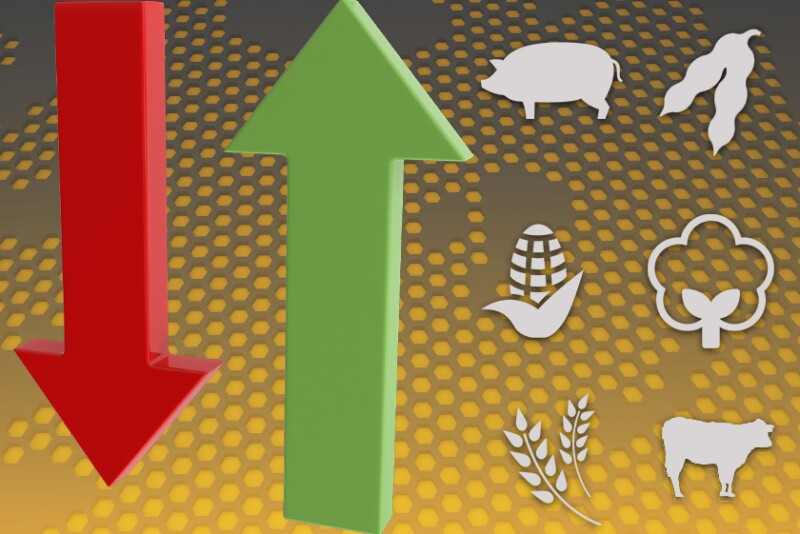GRAIN CALLS
Corn: 1 to 5 cents lower.
Soybeans: 9 to 12 cents lower.
Wheat: 2 to 16 cents higher.
GENERAL COMMENTS:
Corn and soybean futures fell to the lowest levels in a week overnight after weekend rains in the Midwest, easing concern over dry soils. Wheat futures rose to 2 1/2-month highs on signs of stronger demand and smaller crop prospects in top global growing regions. Crude oil futures were lower.
Rains of 1 inch to 2.69 inches fell over southwestern Iowa, east-central Nebraska, southeastern South Dakota and in northern Missouri over the weekend, while a few areas in west-central Illinois received 1 to 2 inches, according to World Weather Inc. The moisture should help corn and soybean crops and the outlook for early August holds few threats. “Overall, during the next two weeks much of the Midwest will get a good mix of weather with temperatures a little warmer than usual in the northwestern crop areas this week and more seasonable next week,” World Weather said in a report today.
USDA’s monthly oilseed crushings report is expected to show 162.1 million bu. (4.864 million short tons) of soybeans were crushed during June, according to analysts surveyed by Reuters. That would be a big drop from the month and year prior when 173.5 million bu. and 177.3 million bu. were crushed, respectively. Tight supplies of old-crop beans and high prices have curbed processing.
AgRural cut its Brazilian corn crop estimate by another 3.1 million metric tons (MMT), dropping it to just 82.2 MMT, down nearly 20% from last year. Besides the production losses caused by drought, recent cold weather has caused additional yield losses and quality problems with the crop.
Strategie Grains held its 2021 rapeseed production forecast for the European Union at 17.03 MMT, which would be a 2.5% increase from the year prior, but the consultancy warned overall supplies of the oilseed would remain tight.
Several crop watchers lowered their wheat production estimates for Russia last week, with supply concerns helping to bolster export prices. The ag consultancy IKAR reports Russian wheat with 12.5% protein loading from Black Sea ports for supply in August climbed $6 from the week prior to $254 per MT, free on board, at the end of last week. The consultancy SovEcon reports prices climbed $10 to $255 per MT of wheat.
In overnight demand news, Egypt tendered Friday to buy an unspecified amount of wheat from global suppliers (Russia is thought to have the lowest offer) and Jordan’s state grains buyer issued an international tender to buy 120,000 MT of milling wheat sourced from optional origins.
CORN: USDA’s Grain Crushings Report today is expected to show corn use for ethanol jump 18% in June to 448 million bu., based on the average analyst estimate in a Bloomberg survey. December futures overnight fell as low as $5.40 3/4, the lowest since $5.32 1/4 a week ago.
SOYBEANS: USDA’s monthly Oilseed Crushings Report is expected to show soyoil stocks likely ended June at 1.994 billion lbs., which would be a 153-million-lb. decline from the end of May and a 277 million-lb. decline from year-ago. November soybeans overnight fell as low as $13.36 1/2, the lowest since $13.32 a week ago.
WHEAT: September SRW futures rose as high as $7.19 3/4, the highest intraday price since $7.23 1/2 on May 14. Spring wheat was also stronger on expectations drought will result in a sharply reduced harvest. Last week, scouts on the Wheat Quality Council’s spring wheat tour estimated North Dakota’s crop will yield 29.1 bu. per acre on average, compared to the tour’s 2015-2019 average of 43.6 bu. per acre.
CATTLE: Steady-firm
HOGS: Steady-mixed
CATTLE: Cattle futures closed last week on a soft note, but firm cash fundamentals may limit further downside. Choice cutout values averaged $278.46 last Friday, up 4.4% for the week and the eighth consecutive daily gain since the market hit a 3 1/2-month low in late July. Live steers in top feedlot regions averaged $121.05 to end last week, down from the previous week’s average of $120.77. Beef demand has been solid and supplies are relatively tight, even with cattle slaughter running 4.5% above year-ago levels. Packers boosted slaughter as margins improved. Last week, U.S. cattle slaughter totaled an estimated 649,000 head, up 0.2% from the previous week and up 2% from the same week a year ago. Packer margins reached $515 a head last week, up nearly $100, according to Hedgers.Edge.com.
HOGS: Hog futures slumped at the end of last week, but stronger retail demand and firm wholesale pork prices may limit further declines. Carcass cutout values averaged $123.89 last Friday, up 1.2% for the week and near six-week highs, according to USDA data. Carcasses on national direct markets Friday averaged $101.70, down from $104.59 at the end of the previous week. Packer profit margins rose nearly $10 over the past week, to $28.67 a head, according to HedgersEdge.com. Packers slaughtered an estimated 2.327 million head of hogs last week, down 0.2% from the previous week and down 8.3% from the same week a year ago.

